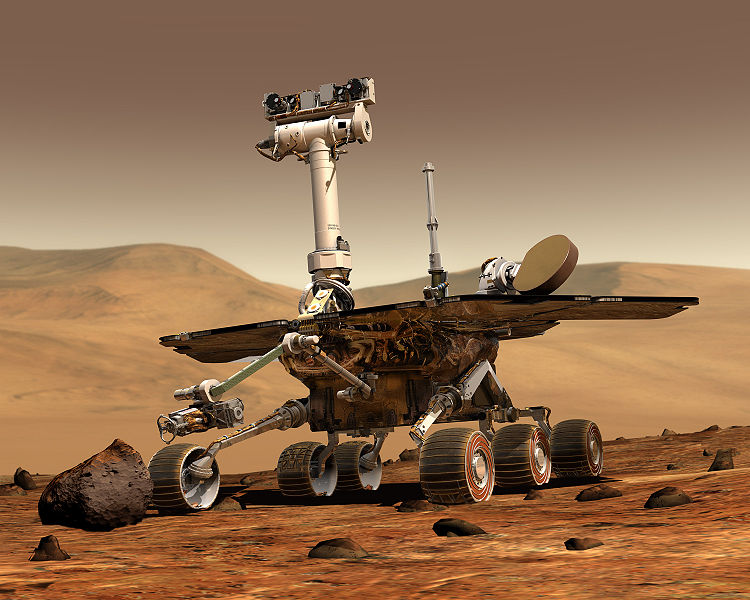Spirit has had a tough time on Mars. Back in 2006, one of her wheels stopped working, and hasn’t worked since. Dragging this wheel along with the other 5 has resulted in some unexpected science, though, by allowing us to see the soil underneath the top layer. Her solar panels have gotten covered by dust, but wind storms have cleaned them off. She’s had computer trouble, rebooting herself and experiencing memory problems, but those inexplicable events seem to have stopped. She’s gotten stuck multiple times in sand traps, but has always managed to get free before.
But not this time. Spirit has been trapped in a sandy patch of soil since May, and her 5 working wheels have dug deep into the sand. Her belly camera might even be deep enough to be stuck against a rock. What to do? Test a replica rover on Earth in a giant sandbox, filled with soil conditions that match those on Mars as closely as possible. Engineers at JPL have been doing these tests for a while now, and have had some success in coming up with new driving methods to try, such as a type of crab-walk. Soon, perhaps in the next week or so, they will send commands to Spirit to have her try out these new moves.

Field testing in planetary-analog settings on Earth has long been a fundamental aspect of space research, both for robotic and human missions. Apollo-era astronauts practiced in the Arizona desert, and current robotic and spacesuit research groups at NASA Johnson Space Center (JSC) practice in the Arizona desert nearly every year. As a side note, one such group, involving JSC and several other NASA centers, is performing dry runs at JSC’s rock yard this very week in preparation for desert testing later this year. They are testing the Lunar Electric Rover, a prototype of a pressurized rover that will allow astronauts to drive and explore around the moon for up to two weeks at a time. (See http://www.nasa.gov/exploration/home/LER.html )
Such field testing is invaluable, but cannot predict every situation that might occur on another planet. Fortunately, even if prior testing didn’t predict a problem, later testing can help evaluate and solve new problems. The sandbox testbed at JPL has helped free rovers before, and will hopefully do so again.
Making driving Spirit more difficult than the average rover is the fact that commands take up to twenty minutes to reach her, and as long again for the results of a drive command to be returned to Earth. (Can you imagine trying to free your 4-wheel drive on Earth with that restriction?!) Plus, due to satellite limitations, Spirit’s drivers can only communicate with her twice a day. While Spirit can be told to drive to a certain location, such as a given bearing and distance away, due to wheel slippage, obstacles or other factors, the rover may end up in a slightly different location than expected. If multi-step navigational commands are sent at one time, and the first step is off, the final result may be quite different than desired.
Spirit’s drivers may be able to compensate for some driving characteristics as they get used to a particular area, but as Spirit has driven into different types of terrain, her drivers cannot be certain what results a particular drive command will produce. The current sand trap, for example, is a different type of soil than they’ve seen anywhere else on Mars. On first approach, it looked just like an ordinary patch of soil, hiding the sand trap underneath. But once Spirit’s wheels disturbed the top layer, she just dug right in, unable to generate enough traction to get out.
Spirit has many autonomous capabilities, such as following multi-day plans, obstacle avoidance, preventing low temperatures and low power, and recovering from such conditions if she happens to find herself in a bind. But in this case, she needs human assistance, and her drivers at JPL are more than happy to help. (See http://www.jpl.nasa.gov/freespirit/ )
This demonstrates a great balance between humans and robots, and shows that using both to explore our solar system and beyond is the best choice. Whether the humans accompany the robots to a planetary surface, or stay behind on Earth, both are needed. Robots can take risks, perform long-duration tasks, carry heavy burdens, integrate science tools and data collection, and much more. Humans can brainstorm solutions, quickly identify the unusual and unique, provide direction and motivation, and much more. Together, they are unstoppable. Together, they provide the driving spirit to explore our universe.



Comments